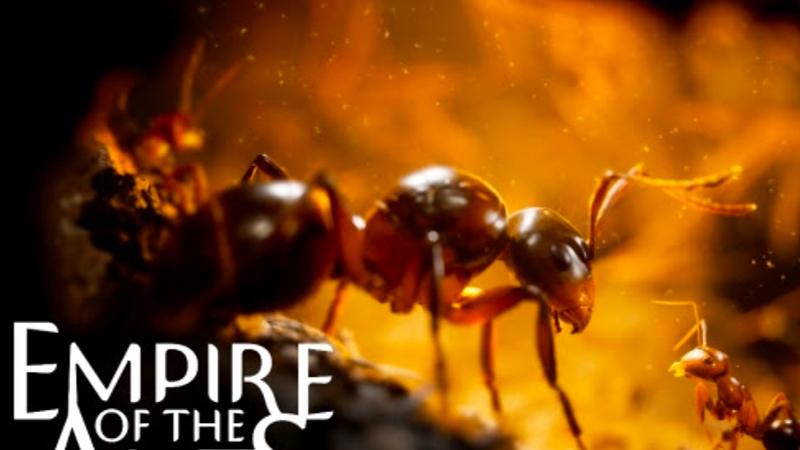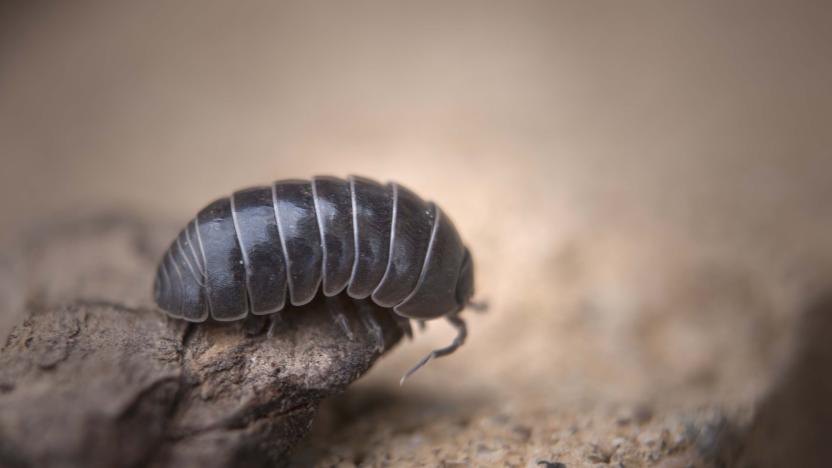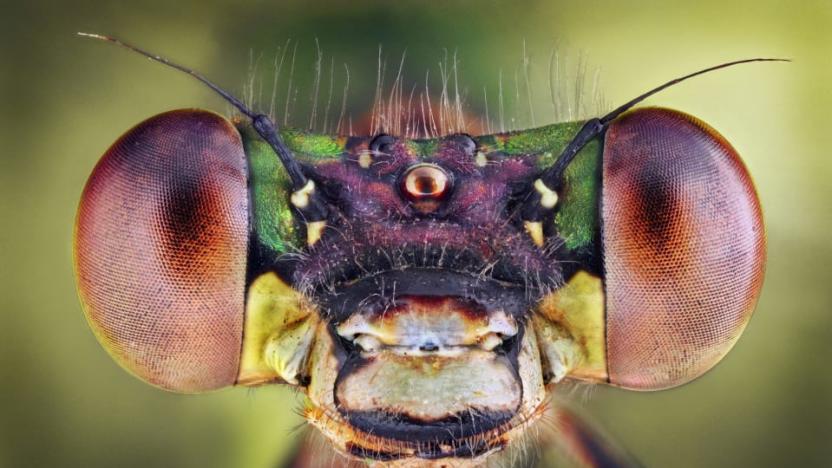insects
Latest

This gorgeous-looking game lets you control a colony of photorealistic ants
Empire of the Ants is a forthcoming console and PC adventure that has you controlling photorealistic insects in a gorgeously-rendered world. It was built using Unreal Engine 5.

Researchers give robots roly-polies for hands
Last summer we got inflatable necrobotic spider corpses. This summer we get captive woodlice grippers. Next summer, arthropods take their revenge.

Tiny robotic fingers let humans interact with insects
Researchers have built robotic 'microfingers' that would let you safely touch insects.

Miniature robotic camera backpack shows how beetles see the world
After creating tiny sensor backpacks for bees, researchers from the University of Washington have built a more advanced model for beetles. Dubbed “a GoPro for beetles,” the robotic backpacks carry a tiny steerable camera that can stream video at 1 to 5 fps and pivot up to 60 degrees.

Get ready to eat bugs if you want to live beyond 2050
By 2050 there will be an estimated 10 billion humans living on this planet. Beyond that being a lot of mouths to feed, those folks will be, on average, wealthier than today's population, with a taste for the foods found in regions like the US and Western Europe. But we simply don't have the capability, the land or the production resources to ensure that many people can eat a cheeseburger whenever the mood strikes. Luckily, researchers from around the globe are working on alternative-protein sources to supplement our existing beef, pork and chicken.

Insects could be extinct within a century, scientists say
Insects are dying so rapidly, they could disappear within 100 years, according to the first global scientific review on their decline. A third of species are endangered and more than 40 percent face the threat of extinction in the next few decades, according to the study, which was published in the Biological Conservation journal.

ICYMI: Barely hoverbiking, new hair dryer tech and more
#fivemin-widget-blogsmith-image-698312{display:none;} .cke_show_borders #fivemin-widget-blogsmith-image-698312, #postcontentcontainer #fivemin-widget-blogsmith-image-698312{width:570px;display:block;} try{document.getElementById("fivemin-widget-blogsmith-image-698312").style.display="none";}catch(e){}Today on In Case You Missed It: YouTuber Colin Furze teamed up with Ford to build a working hoverbike within just a few weeks, from his shed. It runs off of two diesel engines so granted, it's probably not the most mass-production friendly item, but does beg the question: What's holding everyone back, then?

DARPA gives an R/C chopper the legs of a dragonfly
DARPA has revealed a new kind of landing gear that allows helicopters to land on inclines and uneven terrain, a feat that's generally impossible using traditional landing skids. Rather than the fixed landing gear that most helicopters sport, this new set of four articulated legs is designed to work much like an insect's. Each leg is outfitted with force feedback sensors that tells it how much pressure to exert in order to keep the aircraft level, regardless of terrain.

Tiny Robot Can Leap On Water Without Making A Splash
Seoul National University and Harvard have combined with a team of researchers to create a tiny robot that can jump on water. The miniscule stick robot is able to imitate a waters strider's ability to leap from a solid surface of water with the same power and height.Researchers had to collect water spiders and recorded videos of their movements, analysing the mechanics that permit them to jump on and skim the surface of the water. They discovered that a water spider's legs have slightly curved tips which enable it to take off from the water's surface by rotating their legs inward.To ensure that their robot could do the same , they found that the best way for it to jump was to keep leg to water contact for as long as possible during the actual jump motion..By copying this method, the robot can exert up to 16 times its own body weight without breaking the surface of the water. Robert Woods one of the studies co authors said that it was able to do this by spreading out the push needed to jump.If you apply as much force as quickly as possible on water, the limbs will break through the surface and you won't get anywhere... The resulting robotic insects can achieve the same momentum and height that could be generated during a rapid jump on firm ground – but instead can do so on water – by spreading out the jumping thrust over a longer amount of time and in sustaining prolonged contact with the water's surface.The robot was made by manufacturing folded composite structures that self assemble which allow them to make small machines. According to the research team the robots can be employed in useful endeavors such as carrying out pollution checks in waterways, however they emphasized that their goal wasn't to commercialize or profit from their findings.https://www.youtube.com/watch?v=CnFBXM5641k

Researchers develop multifaceted insect eyes for UAVs
A team of researchers from the Laboratory of Intelligent Systems at the Swiss Federal Institute of Technology (EPFL) have developed a tiny new set of electronic eyes for drones that are based on the multifaceted peepers of insects. These eyes are built specifically for the next generation of very small surveillance UAVs -- like that origami quadcopter EPFL developed earlier this year -- and operate very differently than the conventional cameras currently employed. Insect eyes aren't capable of generating a high spatial resolution (that is, the number of pixels you can pack into a single image) so they instead rely on quickly reacting to changes in how light reflects or objects appear as the insect moves. The new camera works the same way.

This is the future of food
Are you ready for lab-made hamburgers, bug-filled protein bars and 3D-printed cuisine? With the Earth's population rapidly approaching 8 billion and the race to keep up with food demand intensifying, industries have begun to drain essential resources and adversely affect the environment. Thanks to some scientific know-how, we're finding new ways to bypass those issues while still bringing natural and nutritious food to the table. In honor of that quest, we've gathered an assortment of forward-thinking products and projects that aim to alleviate the environmental impact of feeding the world and help kickstart a farming future for our space-faring progeny. [Images: David Parry / PA Wire (Cultured Beef); Chloe Rutzerveld (Edible Growth); 3D Systems (ChefJet)]

NASA tests airplane wings that shrug off insect guts
You may not think of insects as a problem for aircraft (Bambi Meets Godzilla comes to mind), but they really are -- the residue from those splattered bugs slows aircraft down and hikes fuel consumption. NASA may soon have a way to keep those critters from causing so much trouble, however. It recently conducted flight testing for a promised non-stick wing coating that stops ex-bugs from inducing drag. The layer, which combines a lotus leaf-inspired ("microscopically-rough") repellant surface with anti-sticking chemicals, was good enough to cut back on the nasty organic residue by as much as 40 percent.

Festo's insect-inspired robots act like the real things
German automation company Festo is known for taking cues from nature when designing robots. This time, it has revealed futuristic-looking bionic ants, realistic robotic butterflies and a silicone gripper based on chameleons' tongue. Just like real ants, the 3D-printed BionicANTs can cooperate in small groups to move bigger objects, though they're much, much larger at 5.3 inches in length. They have cameras on their heads, optical sensors on their bellies that enable infrared navigation, and antennae that function as wireless chargers. Those circuits running outside their bodies are functional, by the way, and not just a design to make them look cool.

'BeeRotor' drone uses an insect-style eye to navigate tight spaces
Accelerometers have become integral components for many of our favorite gadgets. By measuring acceleration forces, such as gravity or someone's arm waving clumsily back and forth, these sensors can accurately identify a device's angle in relation to the Earth. It's how your smartphone knows when to automatically switch between portrait and landscape orientation. Now, scientists are researching how drones can be built to fly autonomously without the use of accelerometers. It's led to the creation of "BeeRotor," which, as the name implies, takes inspiration from the visual cues and analysis used by winged insects.

The future of food, starring crickets and home hydroponics
Humanity currently numbers in the 7 billion range. By 2050, the United Nations expects Earth to house just shy of 10 billion human beings. Sounds like a lot, right? It is, but arthropods ("insects, spiders and other arachnids, crustaceans and myriapods") reading along know better: Our tiny companions outnumber us (and all other mammals) by a staggering margin of over 300:1. Though most of the world is already on board with munching insects, much of Western Europe and North America view the concept as madness. Exo, a Brooklyn-based protein bar maker, is trying to change that. For every $3 bar you eat, the protein you consume is "mostly" from (powderized) crickets, to the tune of approximately 40 crickets per bar. I tried one and can confirm: They definitely taste like protein bars, crickets or not. For Exo co-founder Greg Sewitz, the secret to getting people comfortable with eating bugs is disguising it in foods they're already comfortable with.

Your eco-friendly LED lights are drawing an awful lot more moths
Blue-light emitting LED bulbs have taken off with consumers because they have few downsides -- they're bright, use far less energy and last much longer than other types. In fact, the inventors just won a Nobel Prize, proving their huge benefit to consumers and society. But it now appears there's a teeny issue: flying insects. Scientists in New Zealand tested blue-light LEDs (which look white due to a phosphor coating) against regular yellow-hued sodium-vapor streetlights. The result? The LEDs attracted nearly 50 percent more insects, regardless of the brand and type used. While that could be a pain for your next porch party, there's a more serious downside. The researchers said that when used on city street lamps, the bulbs could interfere with the food chain and even draw invasive species like gypsy moths. [Image credit: swburdine/Flickr]

Manipulating moths in the name of search, rescue and science
In case you needed any more proof that we live in the future, just know that we're slowly inching toward the advent of remote-controlled, sensor-laden moths. (Moths, for the record, are constantly being tinkered with.) As it turns out, the rationale for creating a widespread network of connected, flying insects is more nuanced than just "Because we can." North Carolina State University's Dr. Alper Bozkurt says his team wants to know if they can steer moths through the air to help with search and rescue and post-disaster operations, and the first step toward getting there is sticking electrodes into moth pupae before they fully metamorphose. Alas, the team's still a ways off from achieving their dream - at this point, those electrodes are used to wireless collect information about how moths uses their muscles to flutter through the air. Still, Bozkurt is hopeful that by gaining a better understand of how moths fly, the team will eventually be able to learn how to manipulate those muscles and convert a moth into a tiny living drone.

Scientists identify insects by listening to the music of their wings
It's sometimes tricky to identify insect species, but it's also important -- you want to quickly find out whether you're dealing with a disease-carrying threat or a harmless fly. That won't be an issue once UC Riverside scientists get their audio identification system into the field. Their system uses lasers to translate the fluttering of an insect's wings into an audio signal; since each wing beat has its own music-like tempo and tone, it's possible to identify critters with uncanny accuracy. You can confirm a species 88 percent of the time purely through sounds, and the rate only gets higher when you factor in the location and time of day.

Praying mantises get extra-tiny 3D glasses to test their vision
While 3D video may not be very popular these days, someone's still wearing 3D glasses -- or rather, something. Newcastle University scientists are outfitting praying mantises with very small 3D eyewear to test their depth perception, which is unique in the insect world; most species are limited to 2D. The researchers want to see if the bugs are fooled by the effects of a 3D movie like that you'd see in a theater. If they are, we'll know that they evolved 3D vision similar to that of humans and monkeys.

Mazda is updating car software to fix problems with real, living bugs
Just like Toyota, Mazda's also recalling cars due to a nasty bug -- the difference is, Mazda's problem involves real, live multi-legged creatures. Apparently, the company's recalling roughly 42,000 Mazda 6 sedans in the US, because of a certain yellow sac spider with a penchant for the smell of gasoline. If this spider makes the engine its home, the webs it'll inevitably weave could block fuel flow and increase internal pressure. This, in turn, could lead to cracks and fuel leaks that increase the risk of fire, though the automaker claims it has yet to receive complaints about spontaneously combusting sedans.










